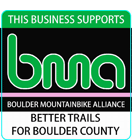24 hours. 4 P.M. to 4 P.M. 19,200 + feet of vertical gain. All in a day's work.
/printed in Performance Bike Shop
Welcome to Montezuma’s Revenge. The world’s highest and the world’s most extreme solo 24 hour mountain bike race.
The logistics of Montezuma’s Revenge can be a nightmare. The race is a series of loops or routes, totaling 201 miles and 35,711 feet of elevation gain and 10 crosses over the Continental Divide. Each loop begins and ends in the town of Montezuma, Colorado at an elevation of 10,500 feet. The highest point is the climb to the summit of Grays Peak at 14,270 feet. (Climbed with our bikes on a backpack to the summit and down the back side, done at night before sunrise).
Some of the men get onto the 9 to 11th loops and the women have begun the 8th loop two years in a row.
I begin preparing for this race months in advance. This means many miles of pre-riding and training, recruiting crew members, and contacting sponsors several times for last minute equipment and promotional material.
I first heard about this race in 1989. I thought the racers were crazy but I looked up to them in an odd sort of way. I thought that all it took was a little bit of preparation and some endurance to get through this race. I was wrong. These racers are fast and have incredible endurance. Rishi Grewal holds the men’s course record and a local Pro racer, Monique Merrill holds the women’s record.
A couple of years ago I ran into one of the race promoters, Byron Swezy. We were having a very lengthy discussion about the discrepancies of women’s and men’s prize lists. Byron was concerned with the growing amount of men entering the race and the lack of interest from women racers. He was considering lowering the women’s prize list and adding that portion to the men’s prize lists. I strongly urged him to think more about this idea. My feeling is this. Why penalize the women that do come to races. You do not get more women to come to a race by lowering their prize list and giving the men a higher prize list. If your prizes go 10 deep and there are 5 women that come to race and finish, give them equal prizes for the 5 places and pass along the other 5 place prizes to the men’s field. Byron asked me why, as a woman, I didn’t race in this event. (Byron had been bugging me to come and race this event for years). The only explanation I had was that for the past several years I had been caught up in road racing and then racing in the NORBA National Series. A weak response, I guess.
The next thing I knew I was saying that if he would forever keep the women’s and men’s prize lists equal, no matter how many women entered the race, I would race in it the next year. We shook hands. That was 1999 and here I am, two years into the race and still counting.
My training for this race actually begins in the early spring with all those long road miles called Base Miles. I do an extra several hundred, as the longer I can stretch my Base Miles out the longer I can hope to keep my summer Peak Periods going. The longer the event I do, that is a major season goal, the more I concentrate on endurance in the spring months.
As I get more and more hours or miles accumulated, I then start to focus on speed work. I am not as good at this training as I am at the endurance training so I do as many fast group rides and shorter mountain bike races to help me add a faster pace to all of that endurance. Short races and training always help the endurance events but these long ultra events kill your speed on the bike. You have to have both in the long races these days as the racers are getting faster and faster.
Montezuma’s Revenge has some unique qualities that make it different from the ‘normal’ 24 hour solo race. The elevation gain and the amount of hiking during the middle of the 24 hour period. This especially makes it hard to race after this 24 hour race because you run the risk of burn out and having absolutely no speed to keep you competitive for the August and September races. I really believe cycling makes your legs or muscles ‘cycling specific”, which is another dilemma in training. I have to prepare for the hiking involved, as well as, the amount of cycling this race requires.
About a month before the ‘Revenge’, I start going to the race loops and pre-riding each loop and hiking the Grays Peak (hiking) loop at least one to two times each. I want to memorize the course and know it in my sleep. I do several night rides on the course to familiarize myself with night riding on single track and to get the light equipment ready. Some would say this is because, being a 24 hour race, we do it in our sleep. Actually as with any race course, the better you know it the better chance you have of placing well.
There are a few good reasons for heading up to the race course about a month in advance. The main reason is that there is still quite a bit of snow on most of the course as it all starts and ends at 10,500 feet and goes up from there. The other reasons are that altitude training, equipment preparation, night training, and race-food choices are all very important parts of the preparation of this race.
As the week before the race nears and all the training preparation is getting sorted out and the crew knows exactly what they will do to help with the race, it is time for the major packing of a life time. We’re talking packing like you’re going on a summer expedition with no stores in the nearest 100 miles.
Every piece of my clothing is labeled with a directive as to what I may call it in the wee hours of the morning. For example. I have a blue pair of Performance Century gloves and I have a blue pair of Performance Winter Goretex gloves. At 3 AM my hands may be cold and all I have to do is ask for the “blue winter gloves” and that is how they are labeled. It’s easier to be very organized before you get to the race than be very confused during the race. All of my food and drinks are labeled, too. Each with a directive as to how to mix it up and how I will probably want to eat it during the race. Eating can be a major problem during a 24 hour race. I practice all of my food options before the race in training and shorter races.
I have had the good fortune to have incredibly efficient and supportive crew members for the last two times I have competed in this race. I would not attempt this race without their support.
After every thing is packed and I have nothing else to do except get nervous, I try to relax for a few days before the race. Work is a big help with this as it takes my mind off of the impending event.
Keeping to race day rituals is another important part of doing well in a race. The more calm and focused you can stay the better you can direct your energy into the race. So, on race day we all head up to the event at about 10 A.M., as the race doesn’t start until 4 P.M. The crew gets all of the gear ready and sponsor banners placed onto the sides of the vehicles and I begin to dress and warm up.
At 3 P.M. we have a racer’s meeting. The basic (and funny) quote of this meeting is, “Do not follow any signs or directions. We did not place any on the course. You should know where you are going as it is a major rule of this race”.
At 4 P.M. the promoters blow up a stick of dynamite the force of which will again be felt and heard once again in exactly 24 hours.
Another hour later all nervousness is forgotten and I settle into a race pace comfortable enough to hold for the next 24 hours.
This year this pace was maybe a little too comfortable. I placed 2nd for the second year in a row but was able to get well into the 8th loop, bettering my own personal best distance and elevation gain. I was actually 9th overall and only ¾ of a loop behind most of those men that placed ahead of me.
The 1st place woman was only 200 yards ahead of me. A mere inch in the world of 24 hour racing.
As always, follow your passion in cycling.
Thanks for reading, Michelle




